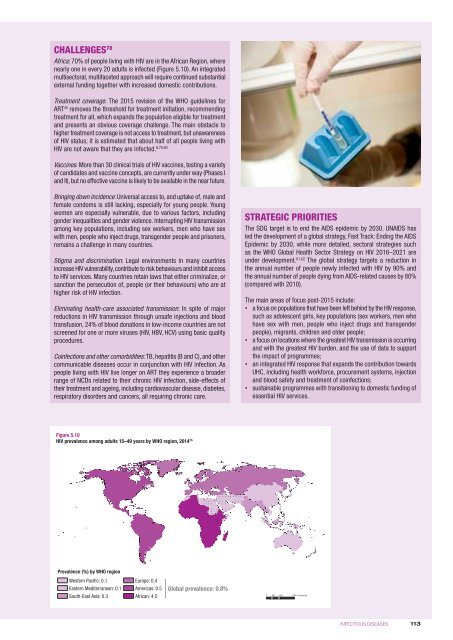Create successful ePaper yourself
Turn your PDF publications into a flip-book with our unique Google optimized e-Paper software.
CHALLENGES 78<br />
Africa: 70% of people living with HIV are in the African Region, where<br />
nearly one in every 20 adults is infected (Figure 5.10). An integrated<br />
multisec<strong>to</strong>ral, multifaceted approach will require continued substantial<br />
external funding <strong>to</strong>gether with increased domestic contributions.<br />
Treatment coverage: The 2015 revision of the WHO guidelines for<br />
ART 45 removes the threshold for treatment initiation, recommending<br />
treatment for all, which expands the population eligible for treatment<br />
and presents an obvious coverage challenge. The main obstacle <strong>to</strong><br />
higher treatment coverage is not access <strong>to</strong> treatment, but unawareness<br />
of HIV status; it is estimated that about half of all people living with<br />
HIV are not aware that they are infected. 8,79,80<br />
Vaccines: More than 30 clinical trials of HIV vaccines, testing a variety<br />
of candidates and vaccine concepts, are currently under way (Phases I<br />
and II), but no effective vaccine is likely <strong>to</strong> be available in the near future.<br />
Bringing down incidence: Universal access <strong>to</strong>, and uptake of, male and<br />
female condoms is still lacking, especially for young people. Young<br />
women are especially vulnerable, due <strong>to</strong> various fac<strong>to</strong>rs, including<br />
gender inequalities and gender violence. Interrupting HIV transmission<br />
among key populations, including sex workers, men who have sex<br />
with men, people who inject drugs, transgender people and prisoners,<br />
remains a challenge in many countries.<br />
Stigma and discrimination: Legal environments in many countries<br />
increase HIV vulnerability, contribute <strong>to</strong> risk behaviours and inhibit access<br />
<strong>to</strong> HIV services. Many countries retain laws that either criminalize, or<br />
sanction the persecution of, people (or their behaviours) who are at<br />
higher risk of HIV infection.<br />
Eliminating health-care associated transmission: In spite of major<br />
reductions in HIV transmission through unsafe injections and blood<br />
transfusion, 24% of blood donations in low-income countries are not<br />
screened for one or more viruses (HIV, HBV, HCV) using basic quality<br />
procedures.<br />
Coinfections and other comorbidities: TB, hepatitis (B and C), and other<br />
communicable diseases occur in conjunction with HIV infection. As<br />
people living with HIV live longer on ART they experience a broader<br />
range of NCDs related <strong>to</strong> their chronic HIV infection, side-effects of<br />
their treatment and ageing, including cardiovascular disease, diabetes,<br />
respira<strong>to</strong>ry disorders and cancers, all requiring chronic care.<br />
STRATEGIC PRIORITIES<br />
The SDG target is <strong>to</strong> end the AIDS epidemic by 2030. UNAIDS has<br />
led the development of a global strategy, Fast Track: Ending the AIDS<br />
Epidemic by 2030, while more detailed, sec<strong>to</strong>ral strategies such<br />
as the WHO Global Health Sec<strong>to</strong>r Strategy on HIV 2016–2021 are<br />
under development. 61,62 The global strategy targets a reduction in<br />
the annual number of people newly infected with HIV by 90% and<br />
the annual number of people dying <strong>from</strong> AIDS-related causes by 80%<br />
(compared with 2010).<br />
The main areas of focus post-2015 include:<br />
• a focus on populations that have been left behind by the HIV response,<br />
such as adolescent girls, key populations (sex workers, men who<br />
have sex with men, people who inject drugs and transgender<br />
people), migrants, children and older people;<br />
• a focus on locations where the greatest HIV transmission is occurring<br />
and with the greatest HIV burden, and the use of data <strong>to</strong> support<br />
the impact of programmes;<br />
• an integrated HIV response that expands the contribution <strong>to</strong>wards<br />
UHC, including health workforce, procurement systems, injection<br />
and blood safety and treatment of coinfections;<br />
• sustainable programmes with transitioning <strong>to</strong> domestic funding of<br />
essential HIV services.<br />
Figure 5.10<br />
Prevalence (%) by WHO region<br />
Western Pacific: 0.1<br />
Eastern Mediterranean: 0.1<br />
South-East Asia: 0.3<br />
HIV prevalence among adults 15–49 years by WHO region, 2014 15 0 1750 3500<br />
Europe: 0.4<br />
Americas: 0.5<br />
African: 4.5<br />
Global prevalence: 0.8%<br />
875 Kilometres<br />
INFECTIOUS DISEASES<br />
113


